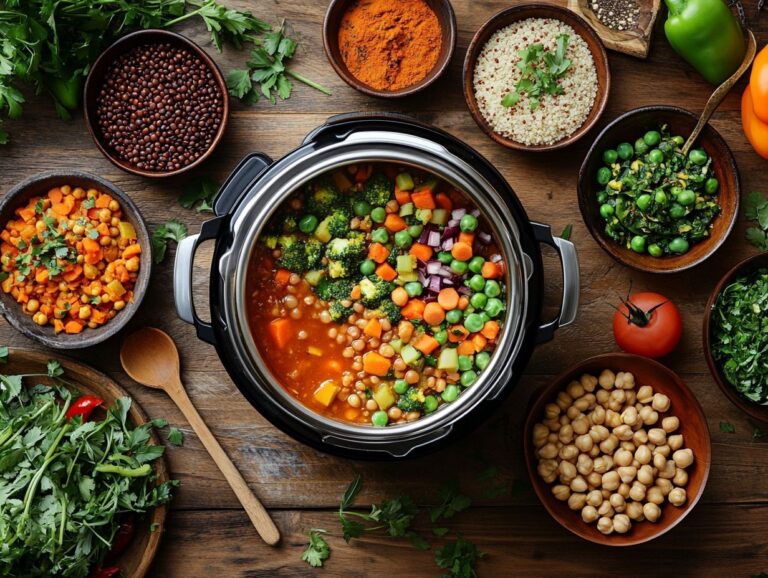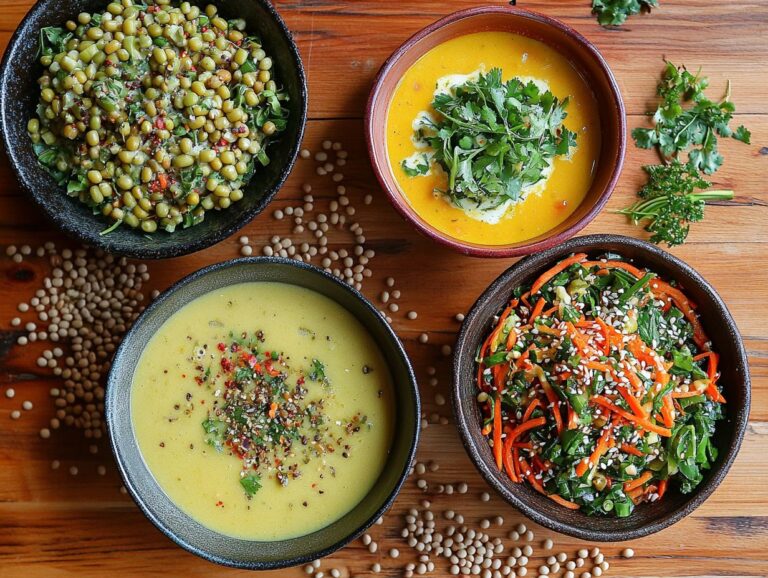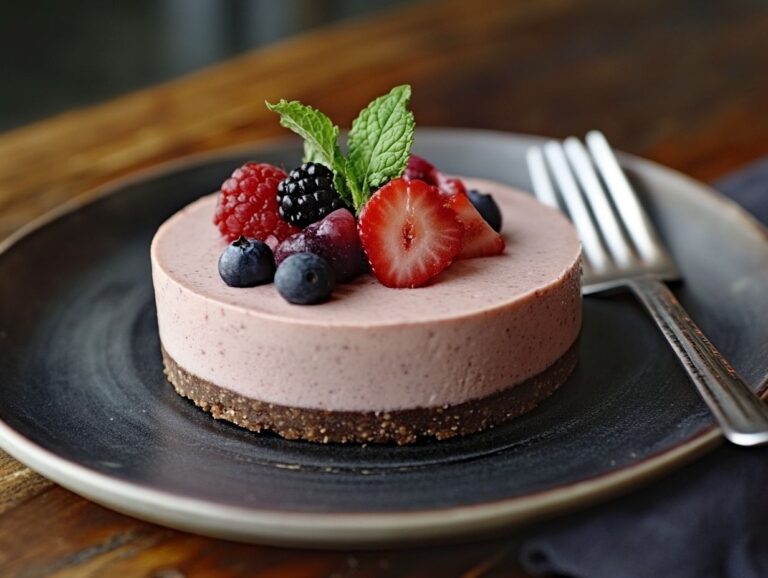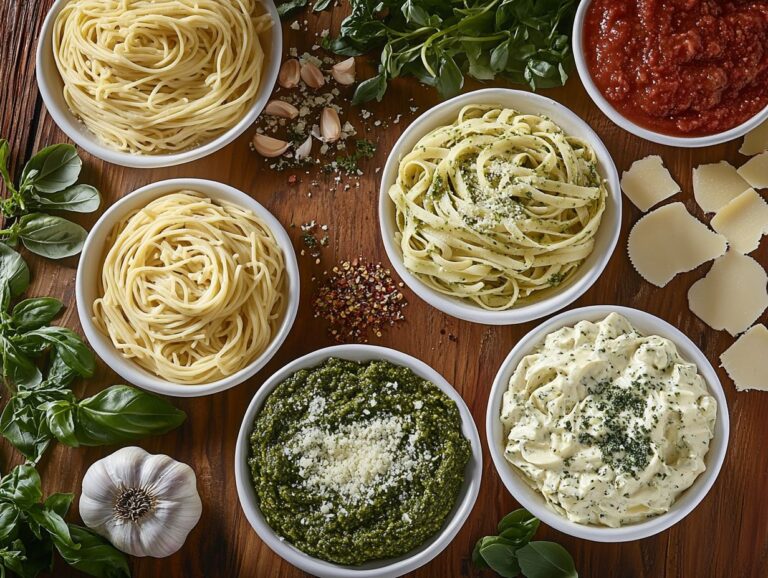Are you ready to explore the vibrant world of vegan Middle Eastern cuisine, where every dish is a celebration of plant-based ingredients and traditional recipes? This article takes you on a culinary journey through the rich flavors and nutritious ingredients that define this beloved food culture, highlighting the beauty of Mediterranean cuisine. Discover the numerous health benefits of adopting a vegan Middle Eastern diet, learn about popular dishes and their traditional recipes, and get acquainted with essential spices and staples, including olive oil and pomegranate molasses. We will share tips for creating authentic meals and offer delicious vegan menu ideas for any time of day. From soups to starters, main dishes to desserts, dive in and elevate your plant-based cooking!
Overview of Flavors and Ingredients
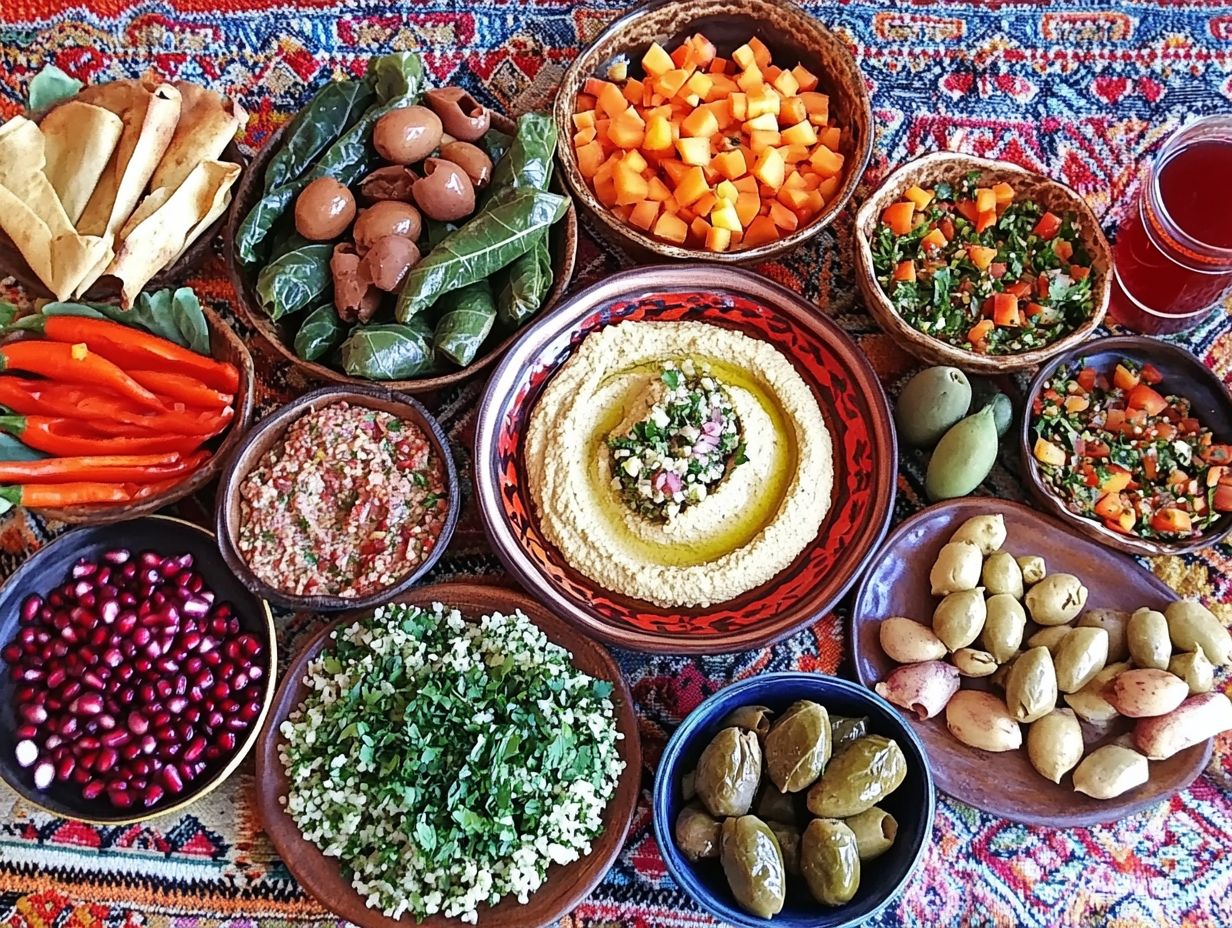 Vegan Middle Eastern cuisine is characterized by a delightful blend of flavors and ingredients that create healthy and delicious plant-based dishes. This culinary tradition incorporates staples such as chickpeas, lentils, and a variety of vegetables, often drizzled with extra virgin olive oil to enhance comfort foods. Authentic seasonings like tahini and pomegranate molasses contribute to the rich flavors found in vegan Lebanese food. Central to vegan Middle Eastern cuisine, particularly Lebanese dishes, is the Mediterranean culture of sharing generous, wholesome meals. The frequent use of legumes, pulses, vegetables, herbs, spices, and healthy fats makes these dishes abundant in dietary fiber, vitamins, and minerals, all of which are essential for maintaining good health. One of the most fundamental ingredients is hummus, a creamy and flavorful dip made from blended chickpeas, tahini (pureed sesame seeds), garlic, and lemon juice. Hummus is a staple in Middle Eastern cuisine and is enjoyed daily by many Lebanese, Syrians, Turks, and other Middle Eastern people. Its rich, nutty taste and high protein and fiber content make it beneficial for heart and digestive health. Falafel is another popular Middle Eastern dish made from spiced, ground chickpeas or fava beans, shaped into balls or patties, and fried until crispy. Renowned for its crunchy texture and delicious flavor, falafel is a favorite among many. Vegan Middle Eastern cuisine also features an abundance of fresh vegetables, such as cucumbers and tomatoes, along with herbs like mint and cilantro, and spices like cumin and coriander. These ingredients not only enhance flavor and texture but also add nutritional value to the meals. The emphasis on fresh ingredients reflects the commitment to wellness that is an intrinsic aspect of Middle Eastern culture.
Vegan Middle Eastern cuisine is characterized by a delightful blend of flavors and ingredients that create healthy and delicious plant-based dishes. This culinary tradition incorporates staples such as chickpeas, lentils, and a variety of vegetables, often drizzled with extra virgin olive oil to enhance comfort foods. Authentic seasonings like tahini and pomegranate molasses contribute to the rich flavors found in vegan Lebanese food. Central to vegan Middle Eastern cuisine, particularly Lebanese dishes, is the Mediterranean culture of sharing generous, wholesome meals. The frequent use of legumes, pulses, vegetables, herbs, spices, and healthy fats makes these dishes abundant in dietary fiber, vitamins, and minerals, all of which are essential for maintaining good health. One of the most fundamental ingredients is hummus, a creamy and flavorful dip made from blended chickpeas, tahini (pureed sesame seeds), garlic, and lemon juice. Hummus is a staple in Middle Eastern cuisine and is enjoyed daily by many Lebanese, Syrians, Turks, and other Middle Eastern people. Its rich, nutty taste and high protein and fiber content make it beneficial for heart and digestive health. Falafel is another popular Middle Eastern dish made from spiced, ground chickpeas or fava beans, shaped into balls or patties, and fried until crispy. Renowned for its crunchy texture and delicious flavor, falafel is a favorite among many. Vegan Middle Eastern cuisine also features an abundance of fresh vegetables, such as cucumbers and tomatoes, along with herbs like mint and cilantro, and spices like cumin and coriander. These ingredients not only enhance flavor and texture but also add nutritional value to the meals. The emphasis on fresh ingredients reflects the commitment to wellness that is an intrinsic aspect of Middle Eastern culture.
Benefits of a Vegan Middle Eastern Diet
The advantages of a Vegan Middle Eastern Diet encompass its health benefits, vegetarian protein intake, and culinary variety. This diet emphasizes legumes, pulses, and fresh vegetables, which promotes overall health while ensuring adequate vegetarian protein necessary for muscle maintenance and growth. Additionally, the diverse flavors and spices found in traditional Middle Eastern recipes create an exciting culinary experience for the palate and help reduce the risk of chronic diseases.
Health Benefits and Nutritional Value
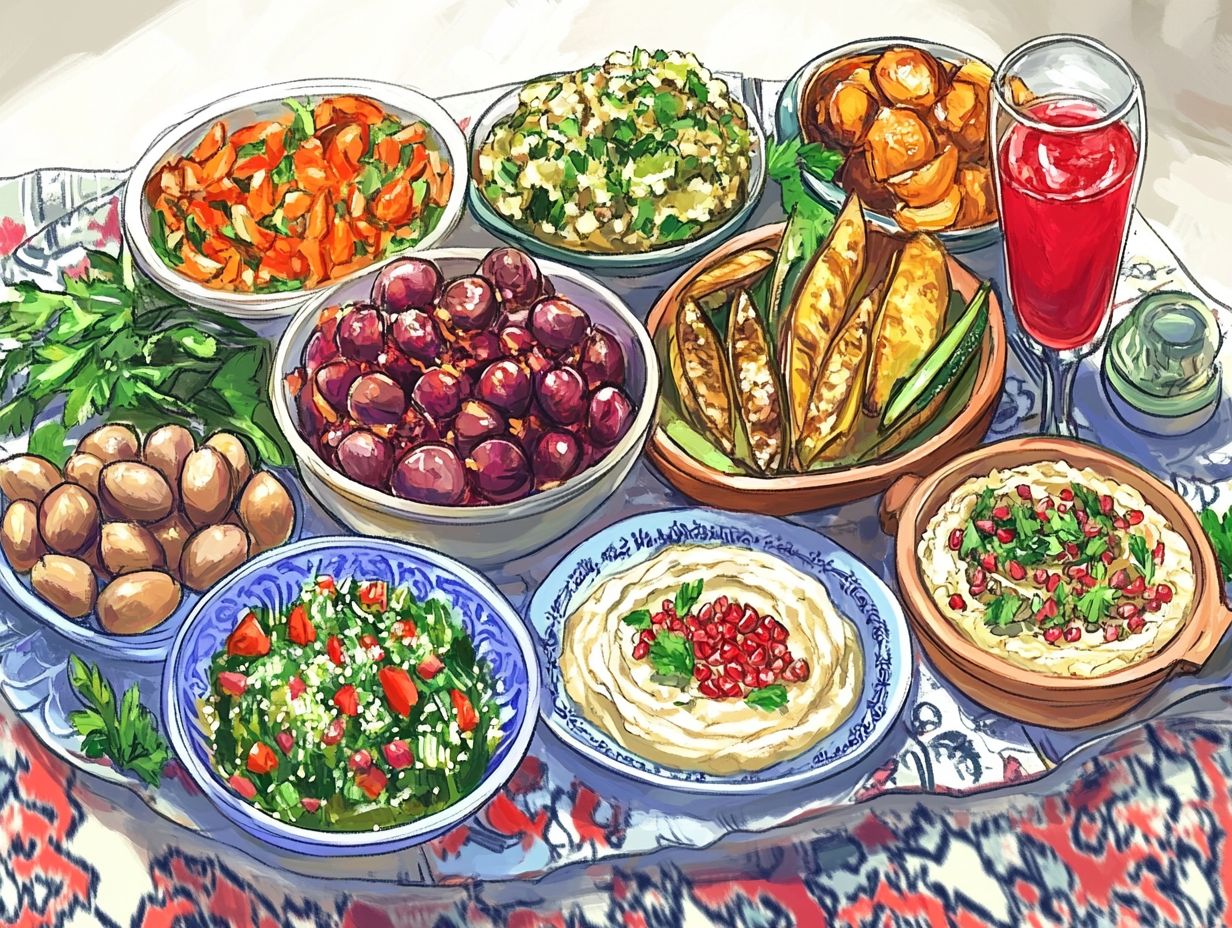 The health benefits and nutritional value of vegan diets are significant, particularly in the context of Middle Eastern cuisine, which is rich in plant-based ingredients that promote overall health and well-being. Staples such as chickpeas, lentils, and a variety of vegetables provide essential nutrients, including fiber, vitamins, and minerals, and serve as excellent sources of vegetarian protein. The use of spices like cumin and coriander not only enhances flavor but also offers anti-inflammatory properties. For instance, chickpeas are an outstanding source of protein, with one serving containing the equivalent amount of protein found in an 85g serving of meat. They are also rich in dietary fiber, with one serving providing approximately 45% of the daily requirement, which is crucial for digestive health as it helps regulate bowel movements, prevent constipation, and lower the risk of chronic diseases. Lentils, often featured in Middle Eastern dishes such as Mujadara, are another excellent source of energy-boosting nutrients like folate, iron, and magnesium. These nutrients support the production of red blood cells, facilitate the transfer of oxygen from the lungs to the body’s cells, and contribute to the energy needed for maintaining a healthy body. Try pairing them with creamy tahini or spicy seasonings for an added twist. Additionally, the diverse array of vegetables used in Middle Eastern cuisine including eggplant, bell peppers, spinach, and zucchini provide vital vitamins A and C, which support the immune system, as well as minerals such as calcium and magnesium that help maintain normal blood circulation.
The health benefits and nutritional value of vegan diets are significant, particularly in the context of Middle Eastern cuisine, which is rich in plant-based ingredients that promote overall health and well-being. Staples such as chickpeas, lentils, and a variety of vegetables provide essential nutrients, including fiber, vitamins, and minerals, and serve as excellent sources of vegetarian protein. The use of spices like cumin and coriander not only enhances flavor but also offers anti-inflammatory properties. For instance, chickpeas are an outstanding source of protein, with one serving containing the equivalent amount of protein found in an 85g serving of meat. They are also rich in dietary fiber, with one serving providing approximately 45% of the daily requirement, which is crucial for digestive health as it helps regulate bowel movements, prevent constipation, and lower the risk of chronic diseases. Lentils, often featured in Middle Eastern dishes such as Mujadara, are another excellent source of energy-boosting nutrients like folate, iron, and magnesium. These nutrients support the production of red blood cells, facilitate the transfer of oxygen from the lungs to the body’s cells, and contribute to the energy needed for maintaining a healthy body. Try pairing them with creamy tahini or spicy seasonings for an added twist. Additionally, the diverse array of vegetables used in Middle Eastern cuisine including eggplant, bell peppers, spinach, and zucchini provide vital vitamins A and C, which support the immune system, as well as minerals such as calcium and magnesium that help maintain normal blood circulation.
Popular Vegan Middle Eastern Dishes
Popular vegan Middle Eastern dishes showcase a wide variety of flavorful and satisfying options that appeal to both vegan and non-vegan palates. Traditional classics like falafel and hummus highlight the deliciousness of plant-based ingredients, offering a taste of authentic vegan Lebanese cuisine that is both healthy and comforting. Other favorites include:
- Vegan Harira Soup, a hearty and nourishing dish perfect for cool evenings,
- Stuffed Middle Eastern Zucchini, filled with a savory mixture of spices and herbs,
- Mujadara, a lentil and rice dish,
- Veggie Maqluba, a layered rice and vegetable casserole.
These dishes embody the essence of Mediterranean cooking, providing hearty meals that are rich in nutrients and flavor.
Traditional Recipes and Vegan Versions
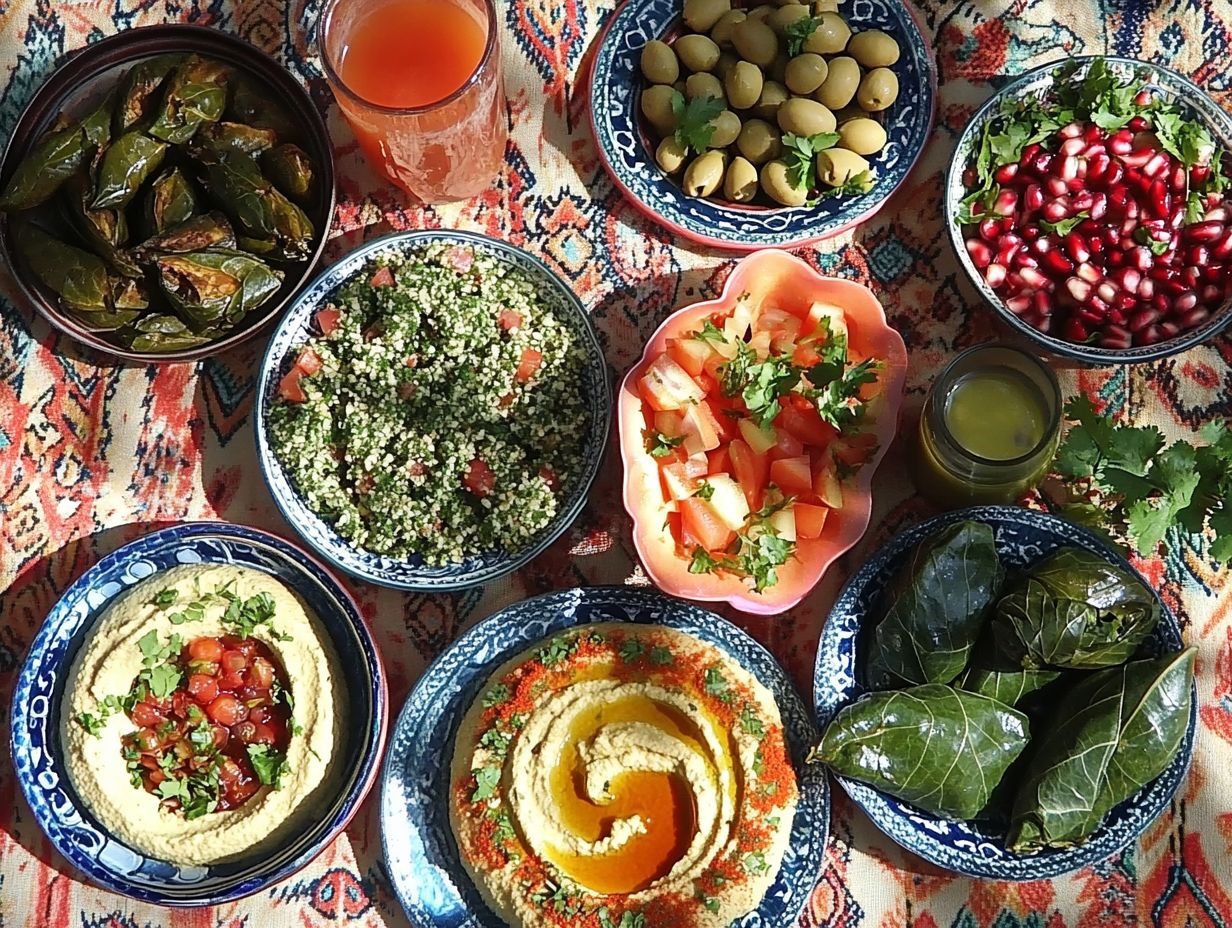 Traditional recipes and variations in vegan Middle Eastern cuisine offer a wide range of delicious options that can be easily adapted to suit plant-based diets, allowing everyone to enjoy iconic dishes like falafel and hummus without sacrificing flavor. These vegan versions maintain the authentic taste while embracing modern dietary preferences. While traditional recipes often rely on animal-based ingredients, many can be reimagined in vegan versions that retain their authentic taste and cultural significance. For instance, transforming a classic spiced dish like Mujadara into a vegan option or creating a creamy tahini dressing for a fresh salad ensures that the comforting essence of Middle Eastern food is preserved while accommodating modern dietary choices. The beauty of these adaptations lies in the vibrant array of spices and herbs integral to the region’s culinary repertoire, including cumin, coriander, and sumac. By substituting ingredients like yogurt with plant-based alternatives such as cashew or coconut yogurt, one can still enjoy the same rich textures and flavors. Traditional dishes like stuffed grape leaves can be easily filled with a mixture of quinoa, herbs, and lemon juice, resulting in a fresh and satisfying meal. It is important to encourage home cooks to experiment with local and seasonal produce, ensuring that they remain true to their culinary roots while personalizing their meals to match their tastes and preferences.
Traditional recipes and variations in vegan Middle Eastern cuisine offer a wide range of delicious options that can be easily adapted to suit plant-based diets, allowing everyone to enjoy iconic dishes like falafel and hummus without sacrificing flavor. These vegan versions maintain the authentic taste while embracing modern dietary preferences. While traditional recipes often rely on animal-based ingredients, many can be reimagined in vegan versions that retain their authentic taste and cultural significance. For instance, transforming a classic spiced dish like Mujadara into a vegan option or creating a creamy tahini dressing for a fresh salad ensures that the comforting essence of Middle Eastern food is preserved while accommodating modern dietary choices. The beauty of these adaptations lies in the vibrant array of spices and herbs integral to the region’s culinary repertoire, including cumin, coriander, and sumac. By substituting ingredients like yogurt with plant-based alternatives such as cashew or coconut yogurt, one can still enjoy the same rich textures and flavors. Traditional dishes like stuffed grape leaves can be easily filled with a mixture of quinoa, herbs, and lemon juice, resulting in a fresh and satisfying meal. It is important to encourage home cooks to experiment with local and seasonal produce, ensuring that they remain true to their culinary roots while personalizing their meals to match their tastes and preferences.
Ingredients Used in Vegan Middle Eastern Cooking
Vegan Middle Eastern cooking relies on a variety of plant-based staples, including chickpeas, lentils, and an array of colorful vegetables. Key spices such as cumin, coriander, and paprika enrich the dishes, while fresh ingredients like herbs, pomegranate, and tomatoes add depth and vibrancy. Together, these flavors and aromas create meals that are both satisfying and nutritionally balanced.
Common Spices and Staples
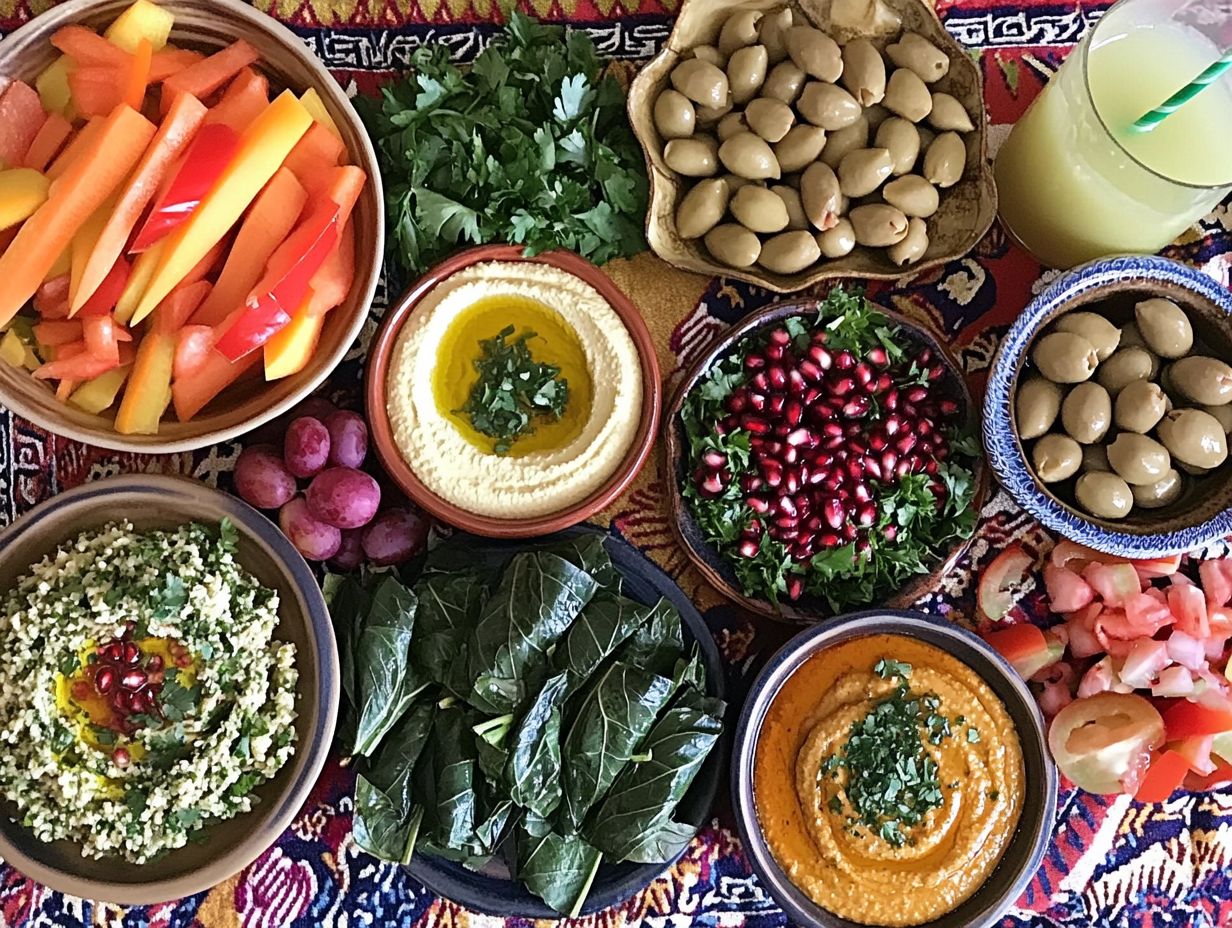 Common spices and staples in vegan Middle Eastern cooking are essential for seasoning dishes and serve as main components in various recipes. Some of the key staples include olive oil, tahini, and pomegranate molasses, each contributing to the distinctive flavors that Middle Eastern cuisine is renowned for. Flavor is a fundamental aspect of Middle Eastern cooking, and several spices play a crucial role in enhancing the taste of vegan dishes.
Common spices and staples in vegan Middle Eastern cooking are essential for seasoning dishes and serve as main components in various recipes. Some of the key staples include olive oil, tahini, and pomegranate molasses, each contributing to the distinctive flavors that Middle Eastern cuisine is renowned for. Flavor is a fundamental aspect of Middle Eastern cooking, and several spices play a crucial role in enhancing the taste of vegan dishes.
- Sumac: Known for its tangy and lemony flavor, sumac can be sprinkled on salads, used in salad dressings, or incorporated into marinades and spice rubs.
- Za’atar: This classic Middle Eastern spice blend is made from hyssop, oregano, savory, marjoram, thyme, or sage, mixed with toasted sesame seeds and salt. Za’atar is commonly added to roasted vegetables and can be mixed with olive oil to create a flavorful dip for pita bread.
- Cinnamon: One of the most popular spices in Middle Eastern cuisine, cinnamon is often used in desserts but is also frequently found in savory dishes like stews. While it is typically associated with sweetness, cinnamon can add a unique depth of flavor to savory recipes.
These spices are often paired with staples such as olive oil, tahini, and pomegranate molasses. The combination of these spices and staples not only enhances the flavor and nutritional profile of meals but also contributes to the cultural significance and culinary traditions that are unique to the Middle East.
Tips for Making Authentic Vegan Middle Eastern Dishes
To create authentic Vegan Middle Eastern dishes, it is important to use traditional cooking techniques, focus on quality ingredients, balance flavors and textures, utilize fresh spices and herbs, adjust seasonings carefully, incorporate extra virgin olive oil, and consider the cultural significance of the cuisine. Traditional cooking methods, such as soaking, grinding, and slow-cooking, are essential for replicating the authentic taste and texture of Middle Eastern vegan foods. Prioritizing high-quality ingredients like extra virgin olive oil, fresh herbs, and spices is critical for maintaining the authenticity and flavor of these dishes. Enjoy a cup of mint tea as a refreshing accompaniment. Achieving a balance of flavors and textures is fundamental to the authenticity of Middle Eastern vegan cuisine. Flavors can vary widely, ranging from mild and creamy, as seen in tahini, to strong and zesty, exemplified by spiced marinated artichokes. Textures can also differ, from smooth and silky dishes like tahini sauce to crunchy and crispy options such as falafel, which is a staple in Vegan Lebanese food. Fresh spices and herbs are crucial in Middle Eastern cooking, especially in dishes like Vegan Harira Soup and Morrocan Zaalouk. It’s important to remember that dried spices lose their potency over time, so aim to use spices that are less than a year and a half old and store them in dark glass containers away from light. These ingredients are essential for creating authentic Vegan Middle Eastern recipes. Carefully adjusting seasonings is vital for achieving authenticity. Essential seasonings such as salt, lemon juice, vinegar, and pomegranate molasses enhance the flavors of Middle Eastern vegan dishes. Salt not only amplifies flavor but also balances other tastes, while lemon juice is typically added at the end of cooking to brighten the dish. Pomegranate molasses adds a unique tangy sweetness that can elevate a variety of Mediterranean cuisine dishes. Using extra virgin olive oil is another key aspect of preparing authentic Middle Eastern vegan cuisine. Olive oil is often used for frying and can impart a spicy note to traditional dishes, which should be embraced. Additionally, olive oil dressing is a fundamental component in many Vegan Middle Eastern recipes, such as the refreshing tabbouleh salad. Lastly, it is important to consider the cultural significance of Middle Eastern dishes, as many hold a special place in society. The region is known for its hospitality, and sharing food is an integral part of this culture. Furthermore, Middle Eastern vegan dishes, including those featuring lentils, chickpeas, and veggie maqluba, often play a significant role in religious practices, such as during Ramadan when traditional foods are served to break the fast.
Techniques and Tricks for Flavorful Dishes
Mastering the art of vegan Middle Eastern cooking requires the use of essential techniques and tricks for creating flavorful dishes. Techniques such as marinating vegetables in olive oil dressing and using the right seasoning blends can significantly enhance the overall taste and aroma of your meals. Incorporating plant-based foods can also add nutritional value. For example, achieving the perfect texture in falafel relies on proper frying techniques and precise ingredient ratios. Utilizing spices and fresh herbs at appropriate stages of cooking can elevate flavor profiles, transforming simple ingredients like chickpeas and lentils into extraordinary dishes. Chickpeas are a key ingredient in many traditional recipes with chickpeas, such as hummus. Exploring cooking methods like roasting can add a depth of flavor that is both robust and satisfying. When vegetables are roasted, their natural sugars caramelize, resulting in a delightful sweetness that pairs beautifully with spices. This method is especially effective in Vegan Middle Eastern dishes like Lebanese Green Beans and stuffed Middle Eastern zucchini. Marination is another important technique; allowing tofu or seitan to soak in a mixture of tahini, lemon juice, and cumin infuses them with layers of flavor. Tahini is a staple ingredient in both Vegan Middle Eastern and Vegan Lebanese cuisines. Additionally, understanding how to balance spices such as sumac, za’atar, and smoked paprika can turn even the most basic grain dishes, such as Egyptian rice, into vibrant and memorable culinary experiences, all while preserving the essence of vegan Middle Eastern cuisine.
Vegan Middle Eastern Meal Ideas
Vegan Middle Eastern meal ideas provide a wide variety of options for breakfast, lunch, and dinner, showcasing the diversity and richness of the cuisine, with influences from Mediterranean and Vegan Lebanese traditions. A hearty breakfast of spiced chickpeas paired with avocado toast can set a healthy tone for the day, followed by a refreshing tabbouleh salad for lunch. Enjoying mint tea with breakfast can complement the meal nicely. For dinner, consider a flavorful medley of roasted vegetables served with fluffy couscous and a side of creamy tahini sauce, ensuring that each meal is both satisfying and delicious while remaining healthy. Add a serving of mujadara for an extra touch of authenticity.
Sample Menus for Breakfast, Lunch, and Dinner
Sample menus for breakfast, lunch, and dinner offer an excellent way to enjoy the delicious flavors of vegan Middle Eastern cuisine while maintaining a proper diet. These menus highlight a variety of dishes that showcase the diverse flavors of the region and inspire creative cooking. The Plant-Based Foods Association often highlights such menus for their nutritional benefits. For instance, a breakfast could feature mint tea alongside avocado toast, complemented by pomegranate seeds or pickled vegetables. For lunch, a falafel wrap might be enhanced with pickles or other crunchy fresh vegetables. Dinner could consist of Mujadara served with a side of baba ganoush, which pairs beautifully with the lentils and rice throughout the meal. Alternatively, try a vegan pizza topped with a variety of Middle Eastern spices and ingredients. Enjoying these meals provides an opportunity to experience the cultural richness of vegan Middle Eastern cuisine while promoting a healthy lifestyle.
